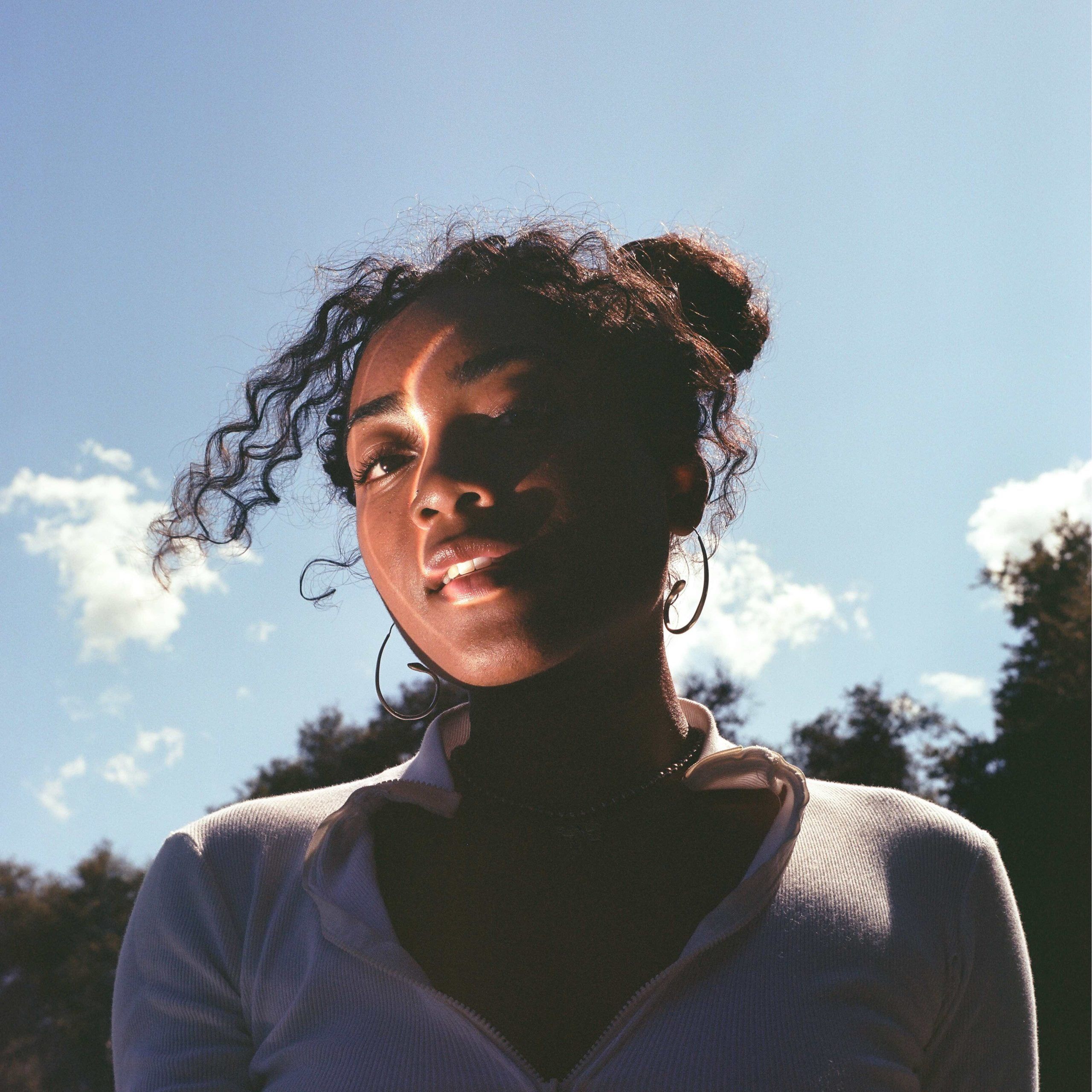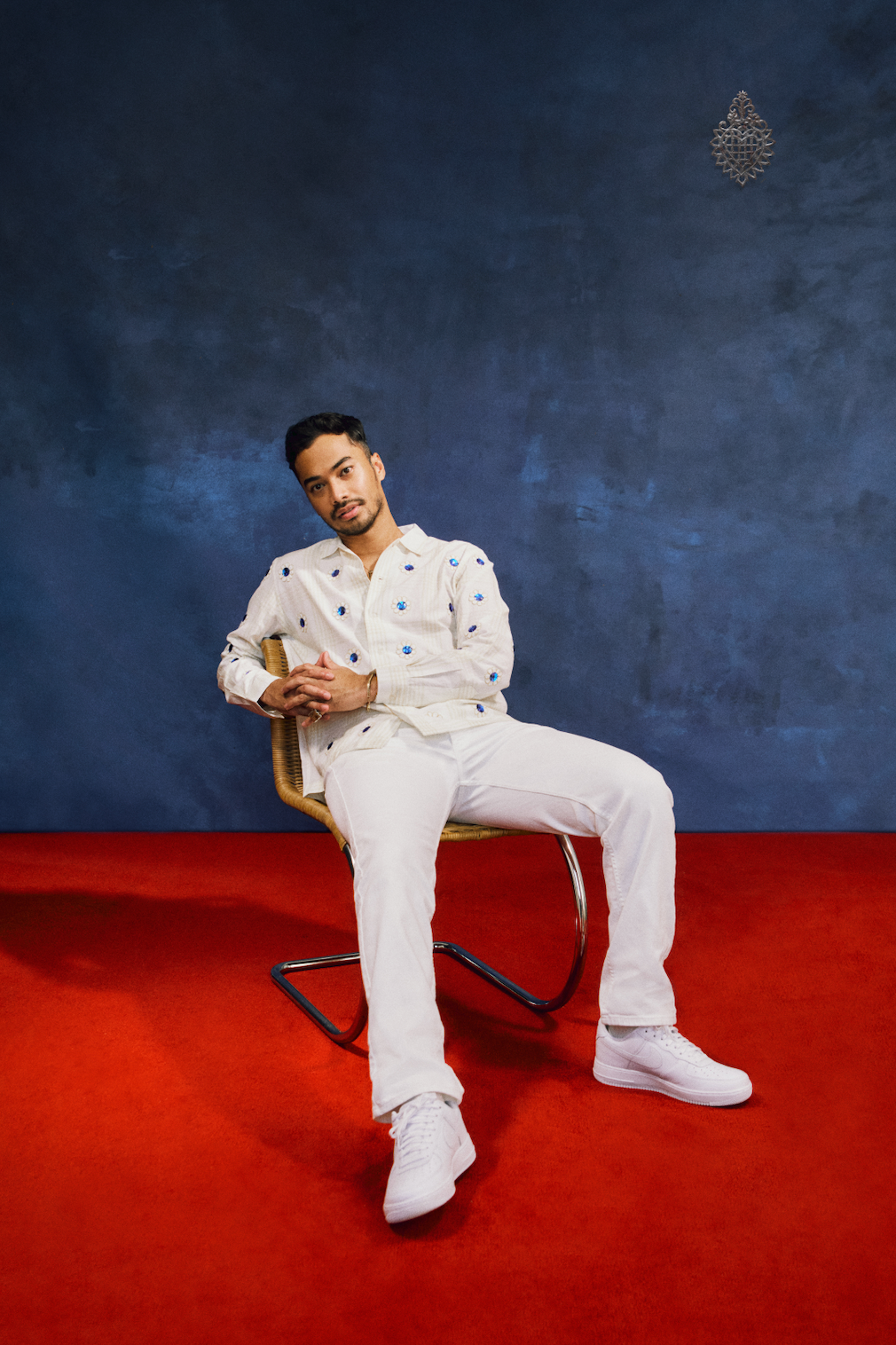
Shane Guffogg
American multimedia artist, Shane Guffogg, creates stunning pieces of abstract art with such precision, it’s astounding.
The LA-native painter, who works in oil, watercolour, gouache, pastel on paper, and sculpture in marble and glass, grew up in a working-class family and became fascinated by the arts from an early age. Whilst being raised on an exotic bird farm in San Joaquin Valley, Guffogg would draw with his mother and take trips to the library to gaze in wonder at old art books, admiring the many different works inside them. Once his late teens arrived, the ambitious individual headed to Europe on his own, visiting galleries and soaking in the likes of works from Da Vinci and Caravaggio to name a few. In the 1980s, the unknown artist at the time set about making a name for himself in the bustling hub of Los Angeles, before working as a studio assistant for renowned American pop artist, Ed Ruscha.
Shane has cut his teeth, honed his skills, and established his name in the art world. He now has work displayed at the Los Angeles County Museum of Art, Nasher Museum of Art at Duke University, in North Carolina, The Imperial Museum of Fine Arts in St Petersburg, Russia, and more. Interestingly, Guffogg has synesthesia, a condition where the brain routes sensory information through unrelated senses, causing the person to experience more than one sense simultaneously. So he can literally hear colours and as a result the art he creates. As someone who’s greatly admired many Italian artists, It’s a dream come true for the painter to finally be exhibiting in Venice.
As of last month, Guffogg has opened his new series of 21 paintings, entitled At the Still Point of the Turning World – Strangers of Time, for Venice’s 60th International Art Exhibition – La Biennale di Venezia, 2024. The whole series is inspired by 20th-century poet TS Eliot’s Four Quartets and it’s completely mesmerising, particularly the main piece of the collection, Only Through Time is Time Conquered. It’s an 84 by 108-inch artwork that’s a visual treat with an abundance of colours and layers of meticulously, carefully drawn strokes. Thematically, it’s the artist’s visual conversation with the poet, and it explores the intersection of time, space, consciousness and transcendence.
Ever the forward-thinking artist, Shane has utilised AI, and augmented reality for this body of work, where an AI algorithm was made to read the musical notes produced by Guffog’s artwork to create a real-life musical composition. By collaborating with the talented musical composer Anthony Cardella and AI programmer Jonah Lynch, Guffogg has extended traditional art’s boundaries, creating an experience that blurs the lines between the real and the surreal.
1883 Magazine’s Cameron Poole flew out to Venice and headed to the historic Scala Contarini del Bovolo, a stunning 15th-century tower, to meet Shane Guffogg and discuss his art, career, and AI.
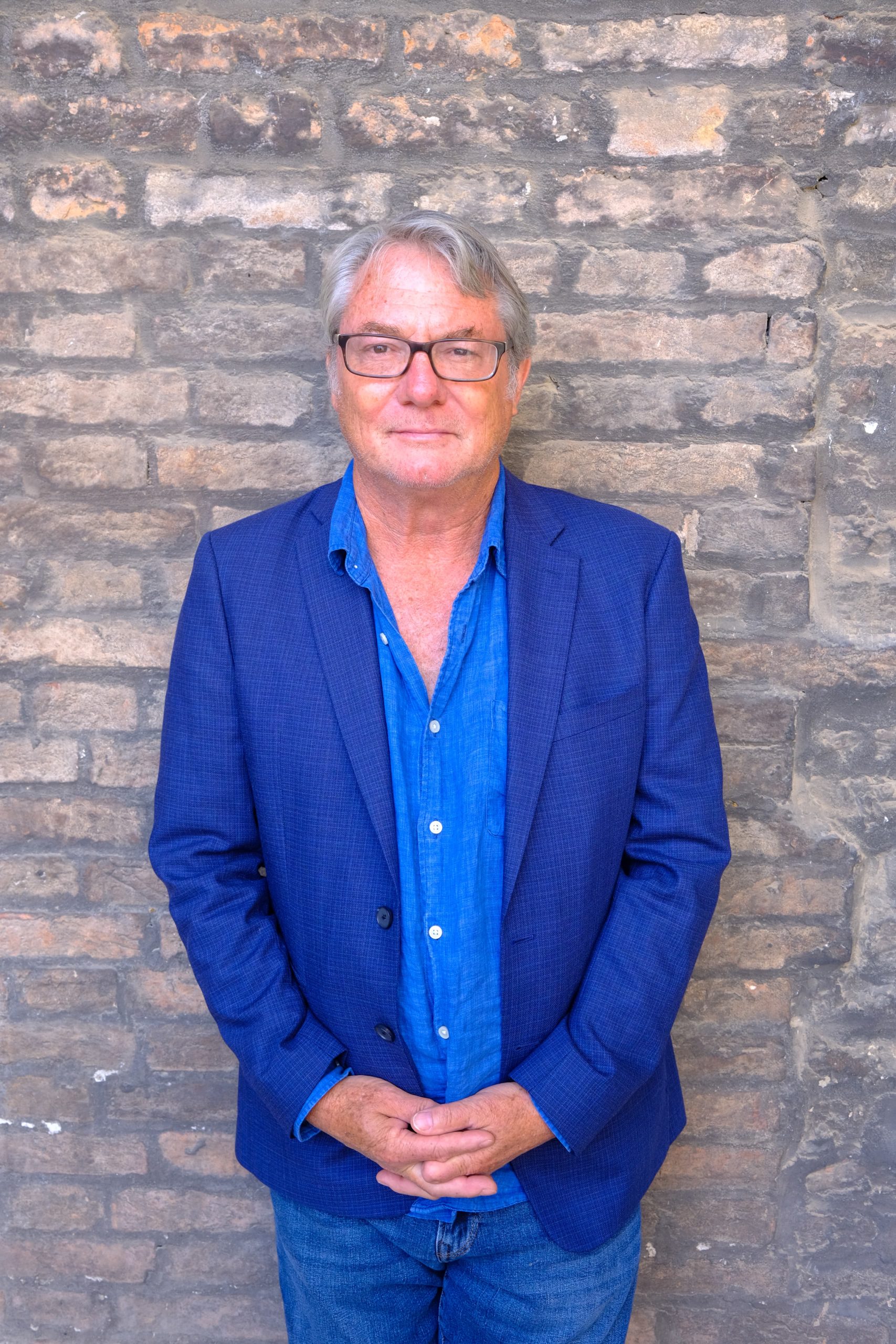
How does it feel to be in Venice displaying your work at this year’s 60th International Art Exhibition? I would imagine this must be extra special?
It’s a great honour for me. Yes, and I did come here when I was 17, travelling through Europe, you know, a backpack and sleeping bag. I was hungry to see real art in person, where I grew up, there was no access to art, or galleries or anything like that; everything was through books.
I remember going to the London National Gallery and standing in front of Rembrandt’s second-to-last self-portrait. It had the most profound impact on me because as I was standing there, I could see all the colours he used, I could see the brushstrokes and it was like something from the ethers downloaded into my brain and I knew how he made the painting. I saw it, it’s clear as day, and then a month later, I was in Milan standing in front of the Last Supper.
And there was nobody in there, I was able to actually go up and push my body against the wall. At that moment, I saw my future. I knew I was going to be an artist. So the question is, how do I get from point A to B to C to D? And when I got back, I started painting feverishly, and I was going to a local junior college. I felt that my paintings at that time were almost educating me more than the classes I was taking; I was learning more from discovery on my own.
And it started to change the way I was looking at the world around me. The paintings did. I started exploring different techniques, I started off with Rembrandt and copying a few Rembrandt’s just to learn his technique. And very quickly, next thing you know, I’m in the realm of Picasso and Cubism, and then I’m looking at Kandinsky, just sort of chewing my way through art history, so to speak. It’s like you’re born inside of a loaf of bread and you have to chew your way out and then go on a walkabout and find your own place that you can cultivate and make your own.
I was here 20 years ago for the artist American artist Edward Ruscha, he was here for the American Pavilion. I was his studio assistant for seven years. So I thought okay, I’m going to have a big show here. I don’t know when, but I can feel it. So the presentation was made last year and I said ‘let’s do it’.
So it’s a great honour for me. It’s a fulfilment of all my thoughts, starting at the beginning. Being an artist, it’s kind of one of the craziest things you can think to do with your life. But if you’re really an artist, you don’t have a choice.
This building is so beautiful. We looked at some bigger spaces, but this to me was everything I needed, everything I wanted. The architecture, the history of it is very important to me. I have a great love of art history, a great love of architectural history, and all those elements are in these paintings.
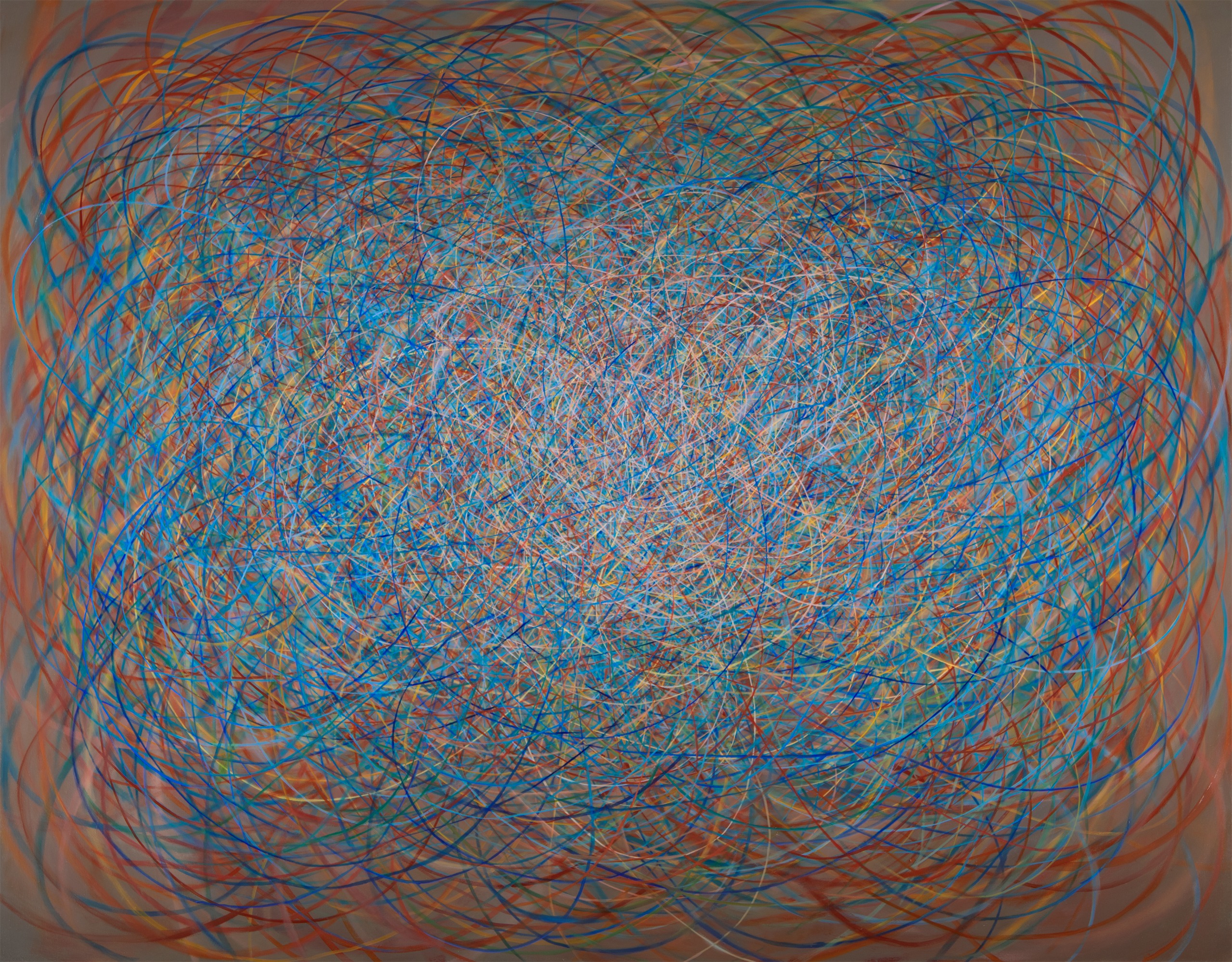
What is it about TS Eliot’s Four Quartets that inspired your latest series of work, At the Still Point of the Turning World – Strangers of Time?
That poem, I have been reading for over 30 years. I pick it up every so often and I read through it or I read a portion of it and I put it down. I’s so dense, you have to let it just sink in. The words even though it’s very plain language that he’s writing in, it’s a profound juxtaposition of thoughts, of times, of places. In my view, he’s taking Eastern ideologies and Western ideologies, about time about space, about what it means to be human, what it means to be a god and he’s weaving these components together. Creating almost for me, it’s a visual tapestry.
And that said, in 2009, I was in Los Angeles and I was elected to a public committee official in downtown LA. I’m sitting there drawing, and I’m listening to somebody give an argument about why they should be able to open a restaurant. I looked down, and I was making these marks. I thought, ‘That’s my still point, ghat’s what I need to find is my still point at the turning world.’ There’s so much information that we’re being bombarded with daily. It’s almost impossible to assimilate it, to make sense out of it. I think for the younger generations, especially, I see their minds just sort of short-circuiting. They can’t take it all in, they don’t know how to stop it. So now they’re terribly confused, angry, lost, and I don’t blame them.
What needs to happen is they need to turn that off, and they need to find their still point within themselves. So as an artist, I thought, ‘well, isn’t that my job to present that as an option as a way to change your thought process? And maybe this will create a shift in your thinking. Maybe you’ll start looking at the world in a different way.’ Just as when I was young, and I saw that first Rembrandt painting, the world opened up for me. My paintings have changed the way I see the world, they change the way I think about the world. My paintings inform me. When I’m watching the news. I’m not thinking about the information they’re giving me. I’m thinking about the impetus that’s going into this information that they’re serving to us and why are they doing it? What’s the motives behind this? Because we don’t get the news anymore, we get…
Fake news?
Yeah, so that poem to me, I realised that I needed to find my still point. Making these paintings was my way of doing that. It’s almost like a form of meditation for me and I’ll work on the paintings for eight hours, with a little brush, making these thin lines, and I move very slowly, very deliberately. Each mark that I make is then has to be countered by another mark. So that it begins to find a balance.
I can relate when I write, It’s sort of my still point, I switch off from everything else and just focus on it. When I look at your artwork in this exhibition, I am amazed by every stroke and every line. Some people might think, ‘Oh, well, you just made each line randomly’, but everyone is deliberate and so much thought has gone into it.
Yes, thank you for acknowledging that. I appreciate it. People ask me do you do this with the machine? Do you do that? I say no.
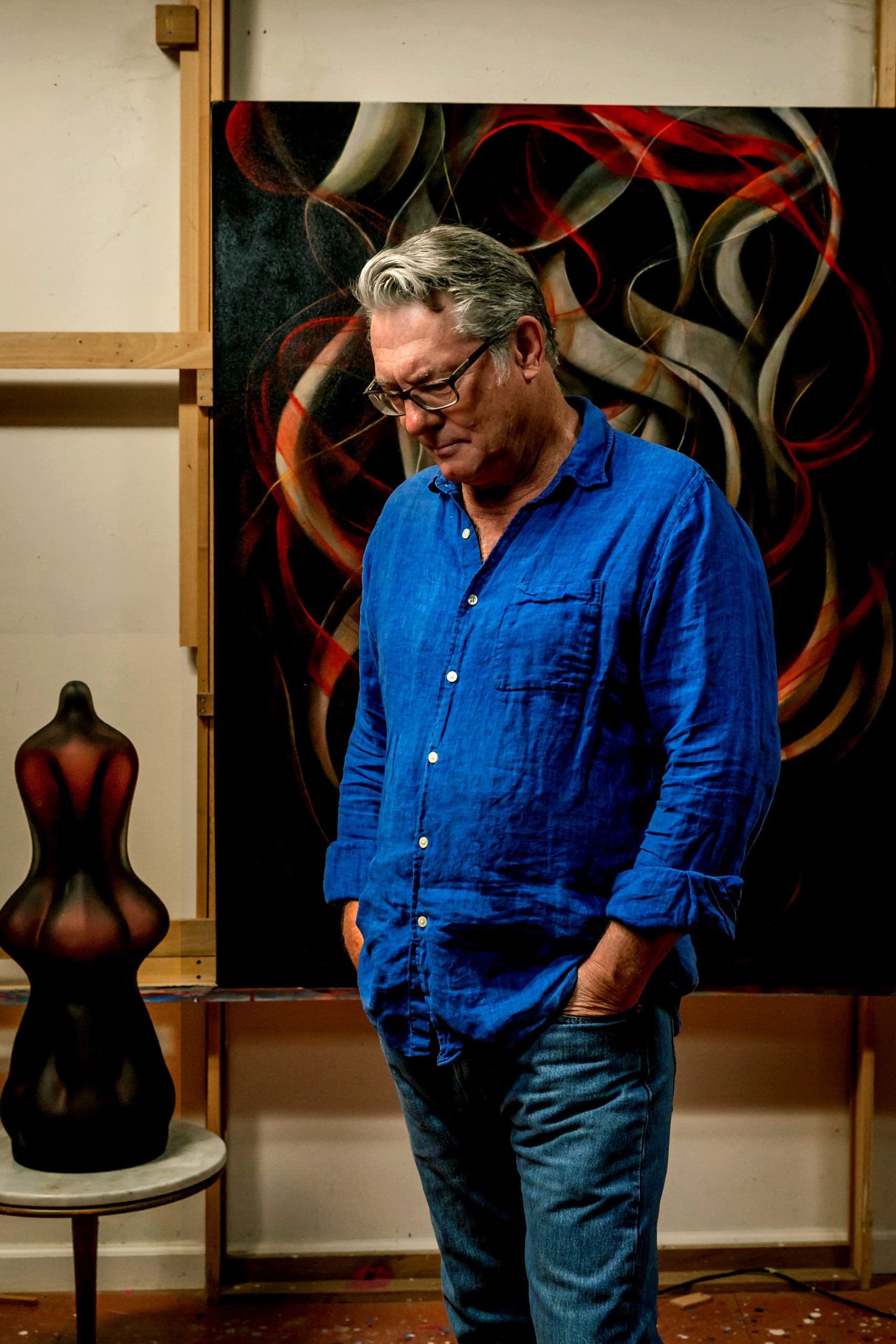
I can imagine some people may think you’ve used a pendulum to create the art but it’s clearly not the case. So what goes through your mind or what do you think when you’re drawing the art or each fine line?
My objective is to have no thoughts. I specifically choose music that I wouldn’t listen to otherwise, some contemporary composers, it’s not necessarily melodic music. It’s a lot of minor chords that are smashing into each other. Jonny Greenwood from Radiohead, the music that he’s composing for soundtracks, it’s some pretty intense stuff that he’s doing, and I’ll listen to his music while I’m painting.
It just clears all my thoughts away. So I’m in the moment, then say I’m choosing a yellow, that yellow, it starts summoning memories for me, not of a specific time or place, but almost sensorial memories of how I felt at a particular time in my life and that colour represents that.
So all those lines are summation of all these memories of time, condensed into a singular moment which is very much what the TS Eliot poem is about.
For me, these paintings, I’m having a conversation with TS Eliot, my visual conversation with him.
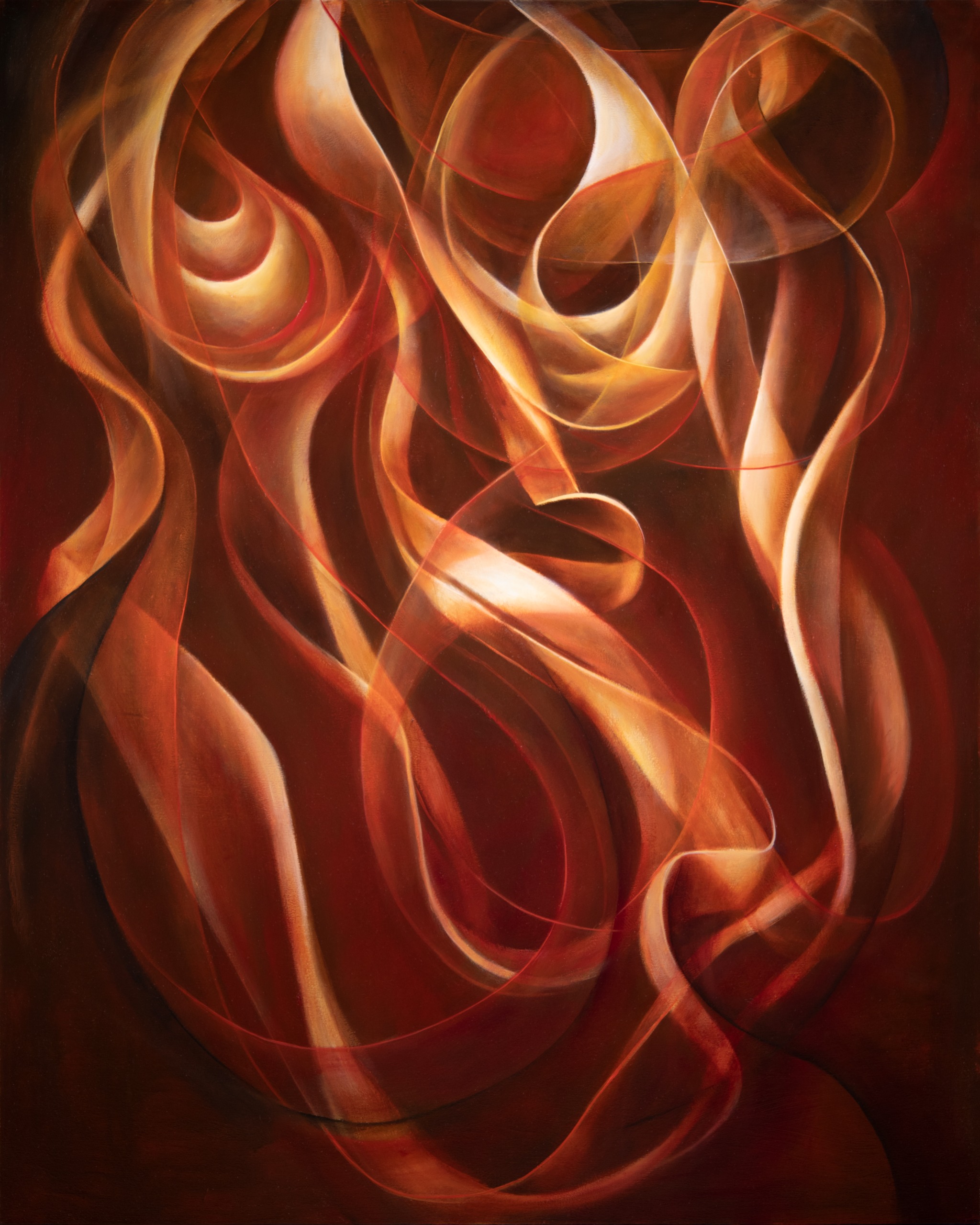
I know your dad was an English coal miner who moved to the US to live the ‘American dream’ and given you lived in a rural area, it sounds like your first real exposure to art was through library trips and your high school art teacher? Could you tell me about those defining moments that helped you foster your passion for art?
My father went to work at the coal mines when he was 15 because he was not very good at school. I don’t think he ever read a book ever. He was very hardworking. It’s all he knew how to do. He was also fearless because he never had anything to lose, basically. So in 1957, he moved to the United States. And then I came around 1962, he married my mother, she was from Los Angeles. And then when I was four, we moved up to this rural area of Lindsay. I was always drawing, my mother would sit and draw with me and she loved art. So she had some art books around that I would just plough through. Then she would take me to the town library, and I check out books for me. And I would look at these books and I’d see these paintings of these old masters and think ;how is this possible’.
In town, there was a little drugstore that had some oil paints, Grumbacher oil paints. So when nobody was looking, I’d take the top off, and I’d smell the oil paint, and then I’d rub it on my skin. I thought, how can somebody take that little smear and create these works of art? That’s magic. I want to be a magician. I didn’t think of it as art, I thought it was magic.
I was always the class artist, you know, there’s always somebody in class who can draw well, so that was me. In high school, a new teacher came and it was his first teaching job, he had just got out of college. He’ll be here tonight, it’s a big thing for him to come.
Anyway, he called to his office, and he said, You’re way beyond me’. Help me to help you. I don’t know how to teach you. So teach me to teach you’. We started this great friendship and I would ask him, what artists should I be looking at? And if I check this book out? Can we sit and talk about these artists? And what are your thoughts about it?
So it was a really beautiful relationship. In that area, the only culture was agriculture. So he was a godsend for me. He was also a football coach, you know, and everybody had to be macho. It was a great time. and then right after high school, I came to Europe with my backpack and sleeping bag. That cemented the deal for me, and I knew who was supposed to be, and what my destiny was.
You moved to LA in the 1980s to find artistic and cultural acceptance, how long did it take you to discover it in such a huge place?
It’s big and when I first moved there, I didn’t know anyone at all. So I got a job waiting on tables and I graduated from Cal Arts, and I was waiting on tables, you’d begin to meet people and they say ‘what do you do? Are you an actor?’ I said I’m an artist. I’d always have snapshots with me as this was before phones, and showed people what I do. I started going to art openings. My objective was to make myself part of the landscape and I just go up to everybody, anybody, and say ‘Hi, I’m Shane Guffogg, what do you do? You should come over and do a studio visit’. And they were like, ‘I don’t collect art’. That’s fine, I don’t care. The more people that see it, the more it exists. So that was my objective then.
In 1989, I started working as a studio assistant for the artist, Edward Ruscha, who’s now at the top of Los Angeles pop artists with his word paintings. He was successful in LA, he wasn’t globally known by any means. It was just the two of us in his studio at that time. Watching him navigate the business side of things daily, I paid close attention and his work ethic, he treated it like a job. We became very good friends and all that played into me, meeting people, and then I’d be invited to a dinner party, and there was an art dealer there and the woman said, you know, ‘I want to see your work’ and so she comes over and says, ‘My son’s opening the gallery, you’ll be the first show’. Things like that happened, like Patric Carpentier who’s the producer of this show.
I knew somebody in LA who was French, and he said, ‘Oh, I know this guy in Paris. He’s an art dealer. He’s very qualified. He can do what needs to be done for you. Let me get a conference call’. So we got on a conference call and he said, ‘Yeah, I’ve been looking at your work, let’s do something’. Okay, like what? ‘A museum show’. This was in 2014, ten years ago. So Patrick said ‘put together 50 images of what you think would make a good museum show and send them to me, and I’ll start chopping them around to museums’.
The first show we did was in St. Petersburg, Russia, at a giant museum, from then there, it went to Baku, Azerbaijan, and then COVID hit. So here we are, now that the world is back right side up, and he said: ‘let’s do something in Venice’. We came here last year, walked around, and both decided on the space. Now here we are.
Patrick is very cool, he never asks ‘Well, what will you paint? What’s the thing?’ He leaves me alone and says, ‘Okay, the paintings need to be finished by October. I then think okay, that gives me six months.
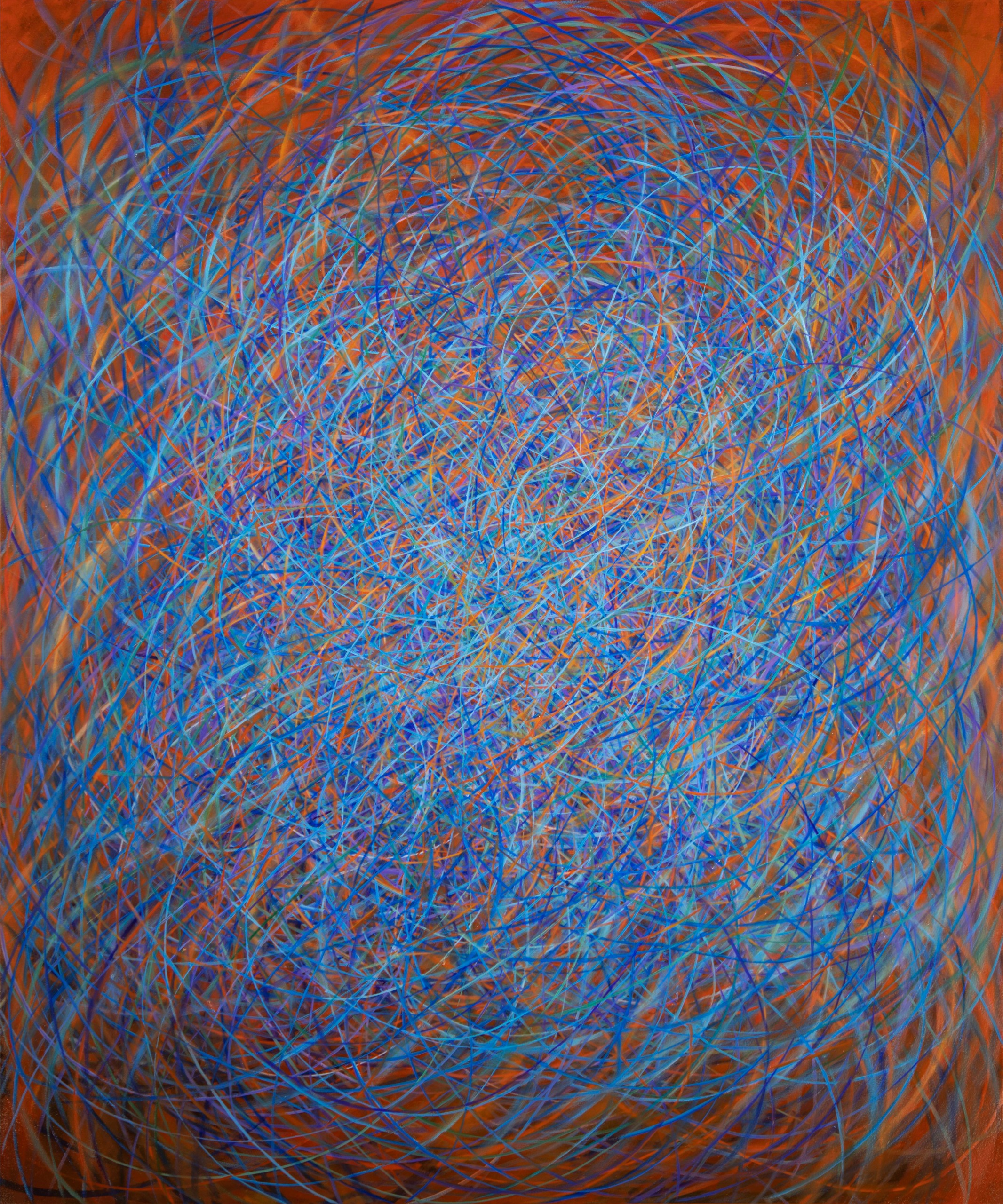
It sounds like a healthy working relationship which is nourishing on both sides. Anyway, Why did you want to incorporate augmented reality and AI in your exhibition?
So about a year and a half ago, I met Tony and he was playing music and I said to him ‘you’re amazing. I want to keep you around. I think we need to collaborate on something’ and he goes ‘okay’. I have synesthesia, so I hear colour, right. I started wondering if there was an AI programme that could read my paintings, this is a thought that I had 15 years ago and I was talking to some computer people at that time and asked if there is a computer programme that could read the paintings and translate it to music? And they’re like, ‘No, doesn’t exist.’
When the AI thing hit, years later I thought maybe this is the time and I started playing around with AR seven years ago, when it first hit the scene a little bit. I thought, well, you know, my paintings are in this one-dimensional format. What if I could extend them out into another dimension. What would that look like? So I’m always asking questions.
And then, with the AI thing, we started looking around to different AI people. And this one woman from India, she said, ‘Well, you have synesthesia, which is something AI will never have. So what you need to do first is map out and like an alphabet and mapping what the chords are, but that required me to then collaborate with Tony, because Tony is a musical genius. Take this painting next to us, I could say that’s a B flat but to what part of the B flat is the question, because the painting’s colour is not a fully realised blue. So there’s some missing ingredients to that blue. Well, how do you represent that in sound?
So Tony starts hitting different variations and when he hits the right sequence of notes, the colour vibrates for me, visually vibrates. So we documented them all. Then the next step is how do we then read the painting and assign where these colours go, what sequence or order do they fit in.
so there’s another guy here today, Jonah. I met him by happenstance, last summer. He’s from northern Italy, but he’s an American, and he’s doing AI software programming. He said, ‘I think I can write a program to do that.’ So he did. He created an algorithm that can read paintings in a similar way that I make the paintings.
So it’s randomly picking spots. Here are these colours, and then it puts it in a sequential order as it’s reading them. That becomes the sheet music. When you first get the sheet music, it’s a bit like a Frankenstein, we’ve created this thing but it is not yet breathing because it’s just a sequence of chords. So it was up to Tony to go back into it again and realise what the chord structures were, and how to connect them using the notes that were there and looking at the paintings. So that was the final step to turn it into a composition.
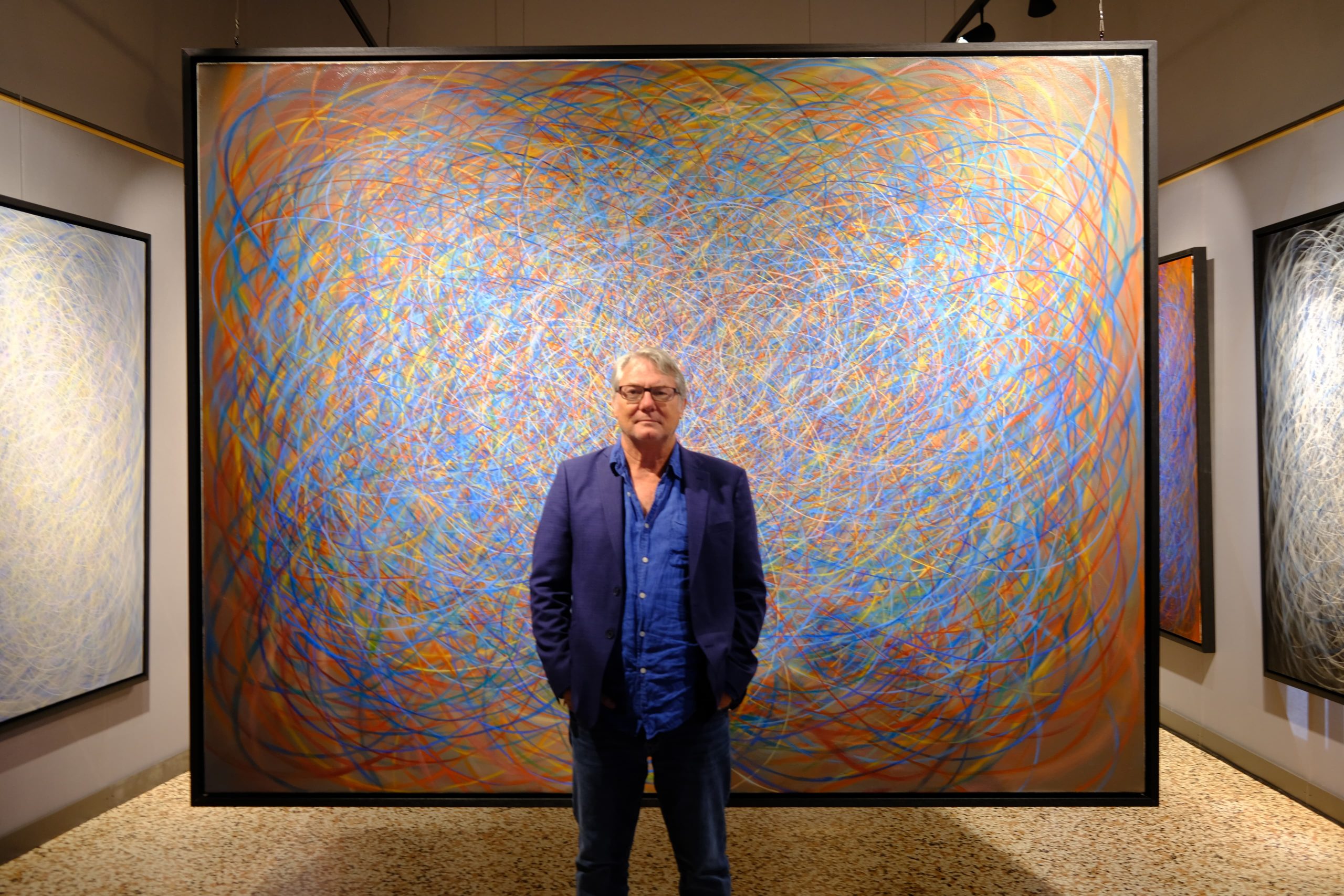
How did you feel when you heard the AI-formed compositions for the first time from your artworks?
The first time it brought tears to my eyes because I hear my paintings anyway and there it was. I was like ‘Oh, my, this is profound.’ So AI is a tool. It’s almost like you have an engine and you have these bolts and you need to take the bolts off to get inside the engine. Well, you need that wrench. Otherwise, you’re not going to get into the engine. So for me anyway, the AI is that wrench.
As someone who has Synesthesia, how has it positively impacted or influenced the way you create art, if at all?
It has immensely influenced how I paint because I have to be very careful, first off of the music that I choose to listen to one, so that influences me and influences my sort of state of mind. Sometimes, my girlfriend, she’ll come into my studio if I haven’t been in the house for six hours, she will come and check on me, and make sure I’m still standing. I’ll have this music going and she’ll be like ‘wow, this is heavy, I can’t stay in here.’ It’s not meant to be listened to it’s meant to be experienced. So in that same sense, the paintings are very musical for me. I see them almost as wordless poems, I think more than anything.
They’re abstract, but they’re also figurative, I’m painting abstraction if it’s a real thing, a real moment in time. For this particular painting [Only Through Time is Time Conquered], we figured out the music for three other paintings previously, and I was still working on this painting, while we’re doing that. So then I thought, what if I document the painting towards the beginning, the middle and the end? And what if the music is in three parts because there are so many colours at the beginning that get covered up. So what if we can explore that through the music, that’s what we’re going to hear at noon today. I haven’t even heard it yet And so Tony’s been working away on it and it’s a sonata in three parts.
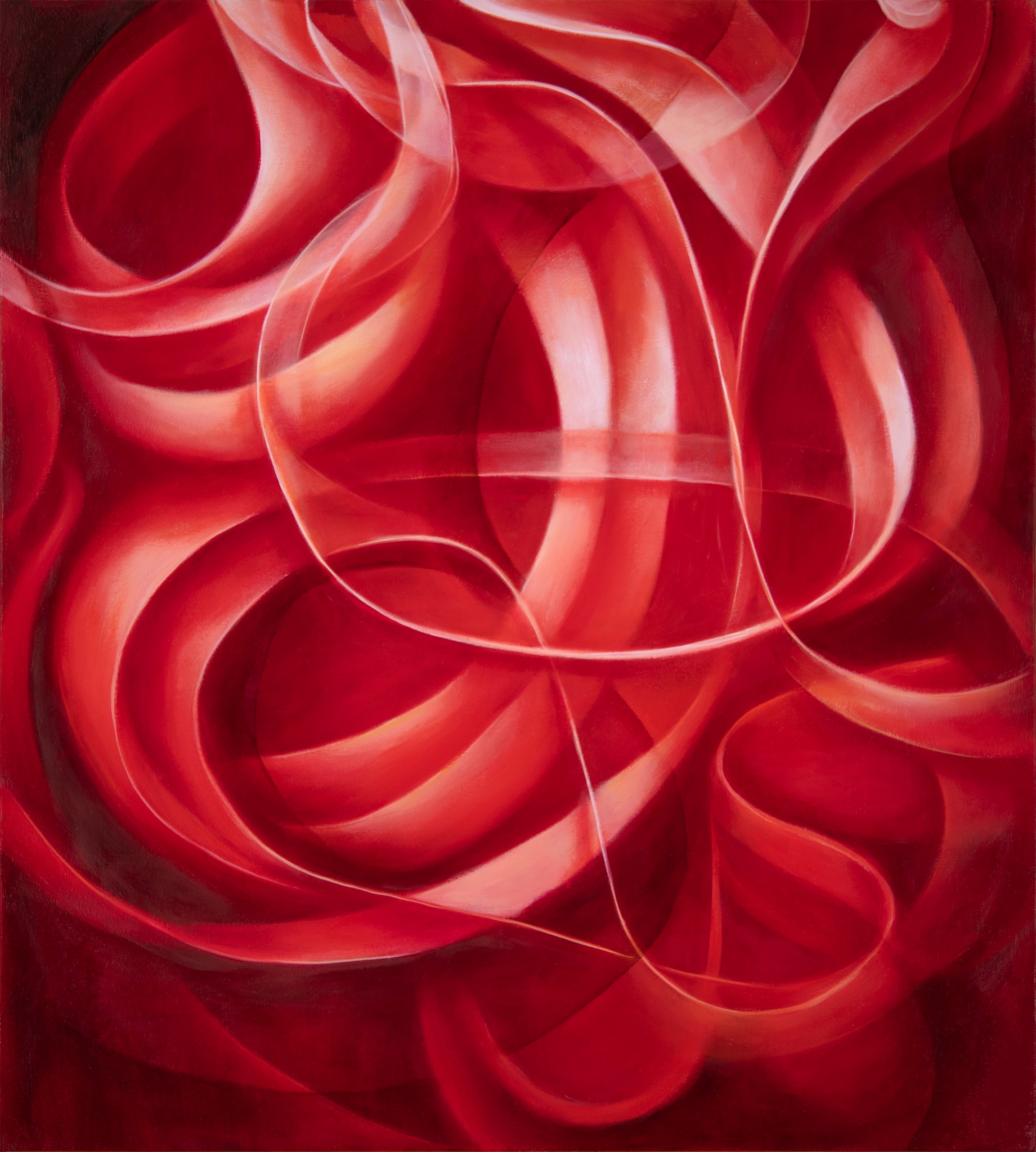
Finally, if there was one certain message you wanted to convey to people who view any of your works, what would that be and why?
To learn to be in the moment, to find your most inner still point. There’s so much noise going on, white noise around us all the time. It can be very disconcerting, and almost harmful. I think It’s set us adrift in uncharted territories and we need to get ourselves realigned with ourselves. That’s what I hope these paintings do, that there’s enough of a presence there with these paintings that it stops you and the paintings that you, engage the viewer engages, and has that stillness of a moment. That’s what I hope that they do.
At the Still Point of the Turning World – Strangers in Time is viewable at Scala Contarini del Bovolo, Venice, until November 24th.
Follow Shane Guffogg by clicking here.
Interview Cameron Poole




